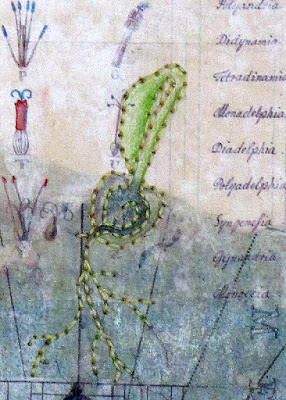Seeds of Dharmkaya
mixed media, 13.5 x 8.25 inches
ingredients: vintage ledger pages, vintage book pages, cut-outs, image transfers, artist pens, metallic ink, watercolor pencils, stitching I can't pretend to fully understand what dharmakaya means, so I have quoted some passages here that make sense to me, in the hope that they will make some kind of sense to you, particularly in relation to the piece. It's a very complex concept, and one that I'm attempting to learn more about.
"Dharmakaya has no categories; dharmakaya is simply being awake. It is the first achievement of a buddha; the first glimpse of vajra-like samadhi. Vajra-like samadhi means cutting through everything, completely and thoroughly. You cut through psychological and spiritual materialism and you cut through the notion of perfectionism as well." (Buddhism beta)
"The dharmakaya is the Absolute; the essence of the universe; the unity of all things and beings, unmanifested. The dharmakaya is beyond existence or nonexistence, and beyond concepts. The late Chogyam Trungpa called the dharmakaya 'the basis of the original unbornness.'
It may be easier to understand dharmakaya in relation to the other bodies. The dharmakaya is the absolute basis of reality, from which all phenomena emanate. The nirmanakaya is the flesh-and-blood physical body. The sambhogakaya is intermediary; it is the bliss or reward body that experiences the totality of enlightenment." (Barbara O'Brien, About Religion)
* Note about the Buddha form:
If you've been following my blog for a while, you've probably noticed that similar Buddha-forms have appeared in several pieces. It is a pre-formulated schematic for painting the body of the Buddha, carefully measured and delineated so it could be followed by all the artists consistently and precisely. I can't remember where I first came across this pattern, but after a short search I was able to find the source of the drawings online. It comes from a book called The Tibetan Book of Proportions,
"an eighteenth-century pattern book consisting of 36 ink drawings showing
precise iconometric guidelines for depicting the Buddha and Bodhisattva
figures.... The concept of the ‘ideal
image’ of the Buddha emerged during the Golden Age of Gupta rule, from
the 4th to 6th century."
I hope all this is of interest to at least some of you, and hasn't bored anyone to death. As I've always said, if you don't read it, I'll never know the difference! I hope that you at least enjoyed the artwork.
Namaste.






It's the whole of it all...composition, color and repeating of image that pulls me in...a universal lesson
ReplyDeleteThank you so much, Mary Ann! I'm glad you think the images work together. Making this piece was a very contemplative experience.
DeleteINTERESTING!
ReplyDeleteThanks so much, Sue!
DeleteI think it all comes down to mindfulness... aware of surroundings at all times.. in the moment...
ReplyDeletewonderful post.
You're right, Donna; I think mindfulness is a big part of Dharmakaya.Thanks for visiting!
Delete